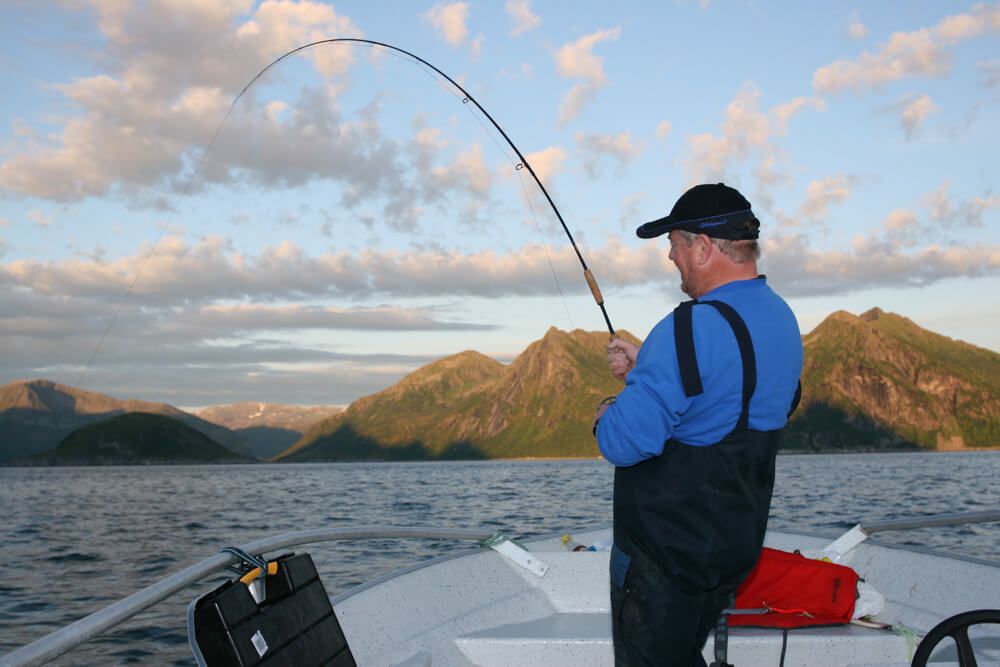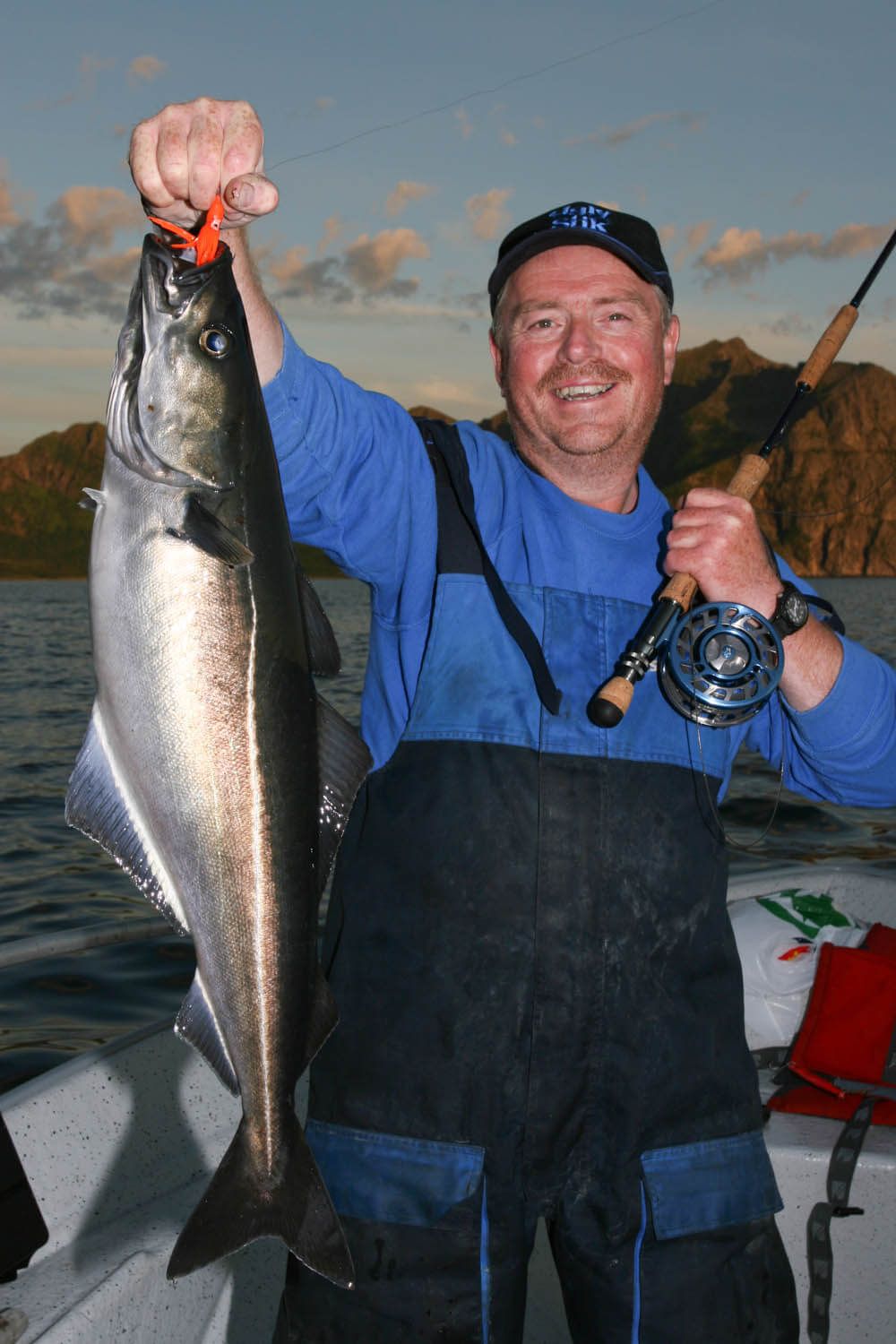Way above the Arctic Circle in the north of Norway, during the late evening just as the midnight sun drifts briefly towards the horizon and the landscape is bathed in a shade of transparent mercury, the plankton rise up through the water column towards the surface. With the plankton come shoals of small baitfish. You can locate these as the smaller coalfish up to a couple of pounds smash the baitfish shoals at the surface and draw in the gulls which are the giveaway as to their whereabouts.
What I’m interested in are the big coalfish that sit anything from 20-metres to 90-metres below the smaller coalies. You can catch these on pirks, retrieved shads and dead small coalfish on big pennel rigs. But I’ve just returned from a trip where I targeted the big coalies on a fly rod.
I’d chosen a 10-weight rod, a big 10 sized large arbour reel and filled it with 300-yards of 30lb braid as backing. My fly line was an experimental 10-weight high-density ultra fast sink line made by Shakespeare and the tippet was 12lb SALT Fluoro carbon. I’d also made some big flies with weight behind the head using sections of small orange muppet tails and some others with twin lead eyes to give the fly some weight to sink quickly after casting.
I was in good company fishing with Ian Peacock, UK representative for Din Tur, a company bringing in anglers from all over northern Europe to fish the rich waters off the Norwegian coast, and Total Sea Fishing magazine editor Barney Wright.
The evening was perfect with no wind and little tide, so the boats drift would be ultra slow.

As the sun fell in the sky the surface water started to erupt in small patches with coalies in the 1lb to 2lb class breaking free of the surface in their effort to catch the baitfish at the surface. We eased the boat in towards the mass slaughter then shut the engine off cruising slowly and quietly in towards the frenzy.
Casting as far as possible and stripping line at speed I instantly hit coalie after coalie up to 2lbs. With a few fish under my belt, I cast slightly away from the shoal and just let the line and lure fall in the water, gently pulling line from the reel feeding yard after yard of fly line off the reel to gain depth. The fly line now gone, I continued to feed off backing line trying to get the light fly down to a depth of around 50-metres plus.
Barney and Ian were taking good coalies on the pirks in the 6lb to 10lb class, but these were deeper than I could easily reach. It was a case of hoping that one or two biggies where closer to the surface.
I was also worried that stripping so much line on to the deck was asking for a major tangle should a big fish dive at speed. I switched to working line off the reel, then lifting the rod tip up from the water surface as high as possible and retrieving line on the downward sweep to give a faster sink and draw retrieve rate.
It was after a dozen or more deep drops that I felt something hit the fly, but no weight came on to the rod tip. Whatever took a swipe at the fly missed it.
Next drop down I’d retrieved maybe 10-metres of line when I felt another tap, then steadily increasing pressure. I lifted the rod tip, increasing the compression curve to maximum by holding the line briefly against the weight of the fish to set the hook, then let go as the fish bored vertically down for the seabed.
God knows how much line the fish tore off the reel, but the inner pads of my finger ends got hot as I tried to add a little pressure to the fast turning spool preferring this “hands on” method than relying on the fly reel drag, as good as they are nowadays.
I’ve no idea how much line the fish took, but it was more than 25-metres, then it paused and went again. Steady pressure and pumping the rod gained a few yards back, then the fish swam in an anti-clockwise circle, before taking the line back.
I was gaining line steadily now, but still having to give some back as the fish still favoured gaining depth on me. It went on one more run gaining another 10-metres of line off the reel, before it went back to turning circles. Pumping line back and I saw the fly line thicken as it neared the tip. Then I saw colour in the water, then the tippet loop and finally the fish broke surface.
Leaning over the gunnel it looked bigger than 7lbs and I could see the fly was well secured in the jaw. I lifted the fish in by the hook shank. Ian weighed the fish on the spring balance at 7lbs 15ozs.

I was hoping for a bigger fish, but the surface slaughter had stopped and the fish gone deeper than I could reach on the fly gear. The boys were still hitting good fish on the pirks way down deep. So I joined them.
I was hoping to try for a double figure coalie on the fly the following night but the weather killed the idea with the wind picking up and making the drift too fast.
You can see some awesome video footage of coalies on the fly in WSF TV.
What I’m interested in are the big coalfish that sit anything from 20-metres to 90-metres below the smaller coalies. You can catch these on pirks, retrieved shads and dead small coalfish on big pennel rigs. But I’ve just returned from a trip where I targeted the big coalies on a fly rod.
I’d chosen a 10-weight rod, a big 10 sized large arbour reel and filled it with 300-yards of 30lb braid as backing. My fly line was an experimental 10-weight high-density ultra fast sink line made by Shakespeare and the tippet was 12lb SALT Fluoro carbon. I’d also made some big flies with weight behind the head using sections of small orange muppet tails and some others with twin lead eyes to give the fly some weight to sink quickly after casting.
I was in good company fishing with Ian Peacock, UK representative for Din Tur, a company bringing in anglers from all over northern Europe to fish the rich waters off the Norwegian coast, and Total Sea Fishing magazine editor Barney Wright.
The evening was perfect with no wind and little tide, so the boats drift would be ultra slow.

As the sun fell in the sky the surface water started to erupt in small patches with coalies in the 1lb to 2lb class breaking free of the surface in their effort to catch the baitfish at the surface. We eased the boat in towards the mass slaughter then shut the engine off cruising slowly and quietly in towards the frenzy.
Casting as far as possible and stripping line at speed I instantly hit coalie after coalie up to 2lbs. With a few fish under my belt, I cast slightly away from the shoal and just let the line and lure fall in the water, gently pulling line from the reel feeding yard after yard of fly line off the reel to gain depth. The fly line now gone, I continued to feed off backing line trying to get the light fly down to a depth of around 50-metres plus.
Barney and Ian were taking good coalies on the pirks in the 6lb to 10lb class, but these were deeper than I could easily reach. It was a case of hoping that one or two biggies where closer to the surface.
I was also worried that stripping so much line on to the deck was asking for a major tangle should a big fish dive at speed. I switched to working line off the reel, then lifting the rod tip up from the water surface as high as possible and retrieving line on the downward sweep to give a faster sink and draw retrieve rate.
It was after a dozen or more deep drops that I felt something hit the fly, but no weight came on to the rod tip. Whatever took a swipe at the fly missed it.
Next drop down I’d retrieved maybe 10-metres of line when I felt another tap, then steadily increasing pressure. I lifted the rod tip, increasing the compression curve to maximum by holding the line briefly against the weight of the fish to set the hook, then let go as the fish bored vertically down for the seabed.
God knows how much line the fish tore off the reel, but the inner pads of my finger ends got hot as I tried to add a little pressure to the fast turning spool preferring this “hands on” method than relying on the fly reel drag, as good as they are nowadays.
I’ve no idea how much line the fish took, but it was more than 25-metres, then it paused and went again. Steady pressure and pumping the rod gained a few yards back, then the fish swam in an anti-clockwise circle, before taking the line back.
I was gaining line steadily now, but still having to give some back as the fish still favoured gaining depth on me. It went on one more run gaining another 10-metres of line off the reel, before it went back to turning circles. Pumping line back and I saw the fly line thicken as it neared the tip. Then I saw colour in the water, then the tippet loop and finally the fish broke surface.
Leaning over the gunnel it looked bigger than 7lbs and I could see the fly was well secured in the jaw. I lifted the fish in by the hook shank. Ian weighed the fish on the spring balance at 7lbs 15ozs.

I was hoping for a bigger fish, but the surface slaughter had stopped and the fish gone deeper than I could reach on the fly gear. The boys were still hitting good fish on the pirks way down deep. So I joined them.
I was hoping to try for a double figure coalie on the fly the following night but the weather killed the idea with the wind picking up and making the drift too fast.
You can see some awesome video footage of coalies on the fly in WSF TV.

